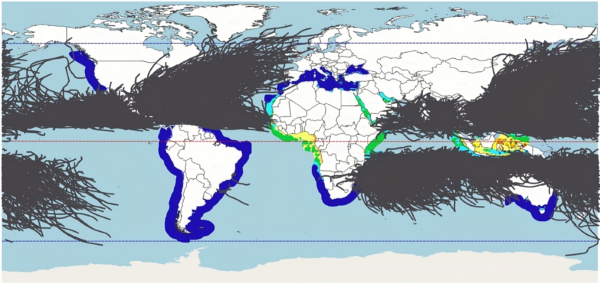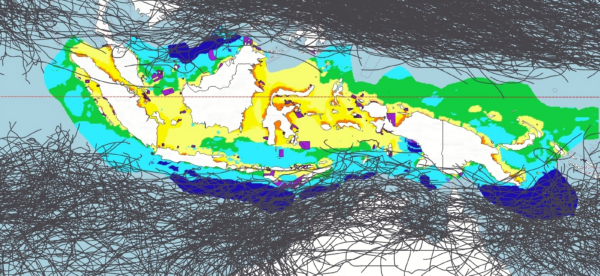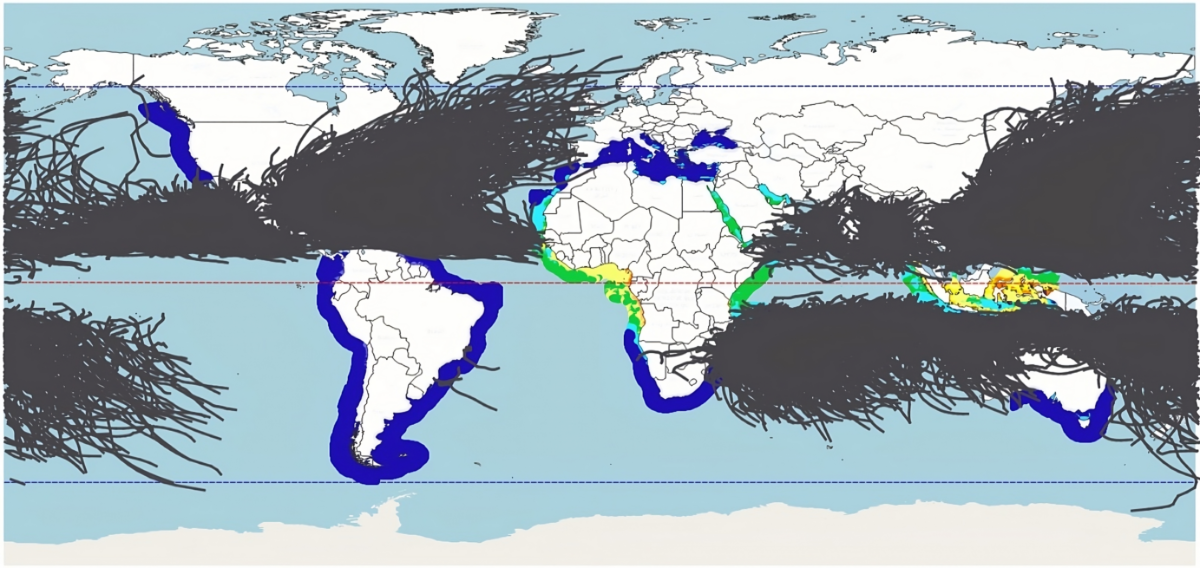Vast arrays of solar panels floating on calm equatorial seas could provide unlimited solar energy to densely populated countries in Southeast Asia and West Africa.
A recent paper shows that Indonesia has about 140,000 km2 of seascape that has not experienced waves larger than 4 m nor winds stronger than 10 m per second in the past 40 years. This is enough area to generate about 35,000 Terawatt-hours (TWh) of solar energy per year, which is similar to current global electricity production (30,000 TWh per year).
While most of the world’s oceans experience storms, some equatorial regions have a benign maritime environment, which means that extensive and expensive engineering structures to protect offshore floating solar panels are not needed.
High resolution heat maps for the world show that the Indonesian archipelago and equatorial West Africa near Nigeria are the most prospective regions for offshore floating solar power arrays.

Figure 1: heatmap for offshore floating solar panels. Red areas are best followed by yellow, green and dark blue. The grey lines show tropical storm tracks. High-resolution maps are here. Author-supplied, using OpenStreetMap base, CC BY-ND
Solar power in mid-century
By mid-century the global economy will be largely decarbonized and electrified, supported by vast amounts of solar and wind energy. In 2050, Nigeria and Indonesia are forecast to be the third and sixth most populated countries respectively.
Their high population densities could cause conflict between agriculture, the environment and solar energy harvesting. Their tropical location (“in the doldrums”) means that wind resources are poor. Fortunately, these countries (and their neighbors) can harvest unlimited energy from solar panels floating on calm tropical seas that don’t experience strong winds or large waves.
About 70 km2 of solar panels can provide all the energy requirements of a million affluent people in a zero-carbon economy. Less energy-intensive societies will be able to supply energy to more than two million people with the same PV panel area. The panels can be placed on rooftops, in arid areas, co-located with agriculture, and floated on water bodies. Floating solar panels can be located on inland lakes and reservoirs, or in offshore protected areas. Inland floating solar has large potential and is already growing rapidly.
A recently released paper surveys the global oceans to find regions that didn’t experience large waves or strong winds over the last 40 years. Floating solar panels in such regions do not require strong and expensive engineering defenses.
Regions that don't experience waves larger than 6 m nor winds stronger than 15 m/s could generate up to one million TWh per year, which is about 5 times more annual energy than needed for a fully decarbonized global economy supporting 10 billion affluent people.
Most of the good sites are close to the equator, in and around Indonesia and tropical West Africa. These are regions of high population growth and high environmental values. Marine floating solar panels could help resolve land use conflict.
Indonesia
By mid-century, Indonesia’s population may exceed 315 million people. About 25,000 km2 of solar panels would be required to support an affluent Indonesia after full decarbonization of the economy using solar power. Fortunately, Indonesia has vast solar energy potential and also vast pumped hydro energy storage potential to store solar energy overnight.
Indonesia is a densely populated country, particularly in Java, Bali, and Sumatra. Fortunately, Indonesia has the option of floating vast numbers of solar panels on its calm inland sea. Indonesia’s maritime area of 6.4 million km2 is 200 times larger than required if Indonesia’s entire future energy needs were met from offshore floating solar panels.
Popular content

Figure 2: Heatmap for offshore floating solar panels in Indonesia. Red areas are best followed by yellow, green and dark blue. The grey lines show tropical storm tracks. High-resolution maps are here. Author-supplied, using OpenStreetMap base, CC BY-ND
Offshore floating solar
Most of the global seascape experiences waves larger than 10m and winds stronger than 20 m/s. Several companies are working to develop engineering defenses of offshore floating panels that can tolerate storms. Benign maritime environments along the equator require much less robust and expensive defenses.
The most prospective regions cluster within 5–12 degrees of latitude of the equator, principally in and around the Indonesian archipelago and in the Gulf of Guinea in the vicinity of Nigeria. These regions have low potential for wind generation, high population density, rapid growth in both population and energy consumption, and substantial intact ecosystems that should not be cleared for solar farms. Tropical storms rarely impact equatorial regions.
The economical scope for offshore floating PV in Central and South America is limited by tropical storms and large waves. The Middle East has large technical potential, although there will be strong competition from land-based solar and wind farms. Europe has some prospects in sheltered areas, such as the northern Adriatic Sea and around the Greek Isles.
The offshore floating solar industry is in its infancy. Offshore solar panels have downsides compared with onshore panels, including salt corrosion and marine fouling. Shallow seas are preferred for anchoring the panels to the seabed. Global warming may alter wind and wave patterns. Careful attention to minimizing the impact on the marine environment and on fishing is required.
Despite these challenges, offshore floating panels could provide a large component of the energy mix for countries with access to calm equatorial seas. By mid-century, about a billion people in these countries will rely mostly on solar energy, which is causing the fastest energy change in history.
Authors: Prof. Andrew Blakers /ANU) & Prof. Ricardo Rüther (UFSC).
Andrew.blakers@anu.edu.au and rruther@gmail.com
ISES, the International Solar Energy Society is an UN-accredited membership NGO founded in 1954 working towards a world with 100% renewable energy for all, used efficiently and wisely.

The views and opinions expressed in this article are the author’s own, and do not necessarily reflect those held by pv magazine.
This content is protected by copyright and may not be reused. If you want to cooperate with us and would like to reuse some of our content, please contact: editors@pv-magazine.com.


4 comments
By submitting this form you agree to pv magazine using your data for the purposes of publishing your comment.
Your personal data will only be disclosed or otherwise transmitted to third parties for the purposes of spam filtering or if this is necessary for technical maintenance of the website. Any other transfer to third parties will not take place unless this is justified on the basis of applicable data protection regulations or if pv magazine is legally obliged to do so.
You may revoke this consent at any time with effect for the future, in which case your personal data will be deleted immediately. Otherwise, your data will be deleted if pv magazine has processed your request or the purpose of data storage is fulfilled.
Further information on data privacy can be found in our Data Protection Policy.